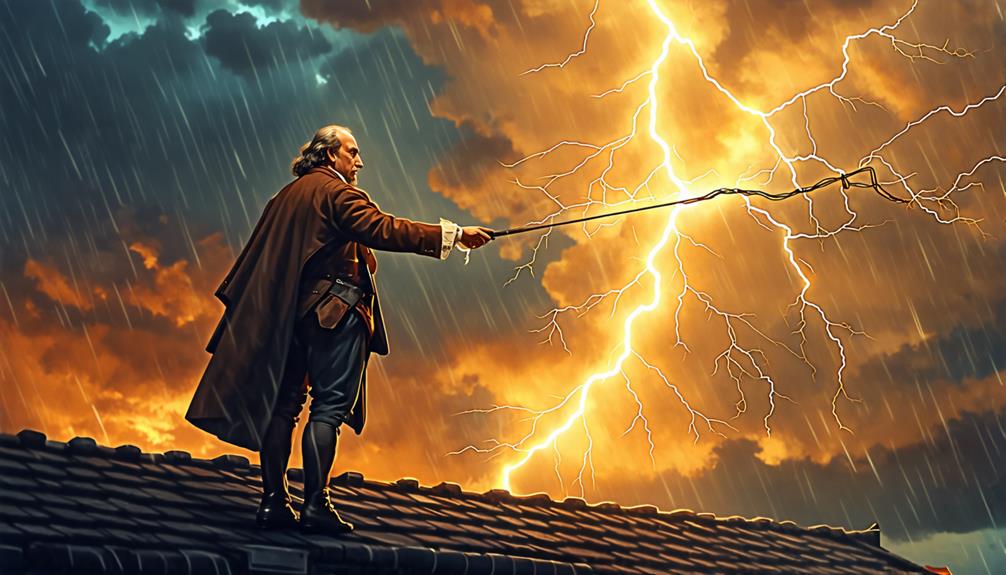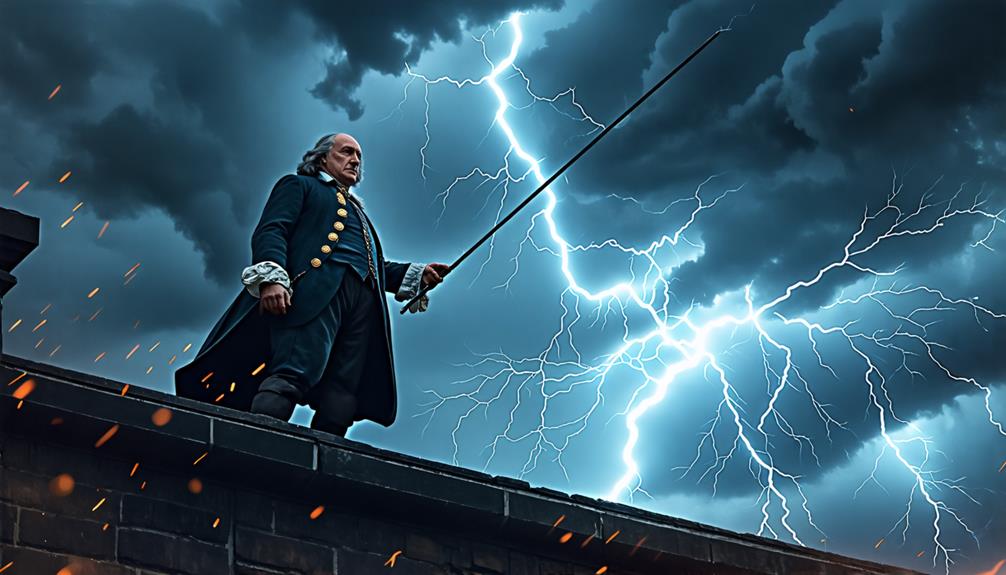You've likely heard of Benjamin Franklin's famous kite experiment, but did you know it led to one of his most important inventions? The lightning rod, conceived by Franklin in 1750, revolutionized building safety and our understanding of electricity. This simple yet ingenious device has saved countless lives and properties over the centuries. But Franklin's journey to this groundbreaking invention wasn't straightforward. It involved dangerous experiments, skeptical peers, and a race against time to protect cities from devastating fires. The story behind the lightning rod's creation is as electrifying as the invention itself.
Key Takeaways
- Benjamin Franklin proposed the lightning rod in 1750 to protect buildings from lightning strikes.
- Franklin's design used a pointed iron rod to conduct electrical charges safely into the ground.
- The invention was based on Franklin's discoveries about the electrical nature of lightning in the 1740s.
- Franklin published his findings and advocated for lightning rods in Poor Richard's Almanack in 1753.
The Spark of Inspiration

While tinkering with electricity in the 1740s, Benjamin Franklin stumbled upon a discovery that would change the course of history: lightning was electrical in nature. This revelation sparked his imagination, leading him to propose the lightning rod in 1750 as a means of protecting buildings from nature's fury. Franklin's groundbreaking idea involved using a pointed iron rod to safely conduct electrical charges into the ground.
To prove his theory, Franklin conducted his famous kite experiment in 1752. By flying a silk kite with a key attached during a thunderstorm, he demonstrated that lightning was indeed a form of electricity. This scientific breakthrough provided the foundation for his invention.
In 1753, Franklin shared his findings on lightning rods in Poor Richard's Almanack, advocating for their use to enhance public safety. That same year, the first lightning rods were installed, marking a significant advancement in understanding and harnessing electrical phenomena.
Franklin's Electrifying Experiment
Franklin's daring kite experiment in June 1752 marked a pivotal moment in scientific history, proving that lightning was indeed a form of electricity. Using a silk kite with a conductive hemp string and a key, Franklin demonstrated that electrical charge could be drawn from storm clouds. He received a mild shock from the key, confirming his theory about lightning's electrical nature.
This groundbreaking experiment laid the foundation for Franklin's invention of the lightning rod. He published his findings in 'Experiments and Observations on Electricity', suggesting the use of iron rods to protect buildings from lightning strikes.
Franklin's work revolutionized our understanding of electricity and provided a practical solution for safeguarding structures against nature's destructive force. The success of the kite experiment cemented Franklin's reputation as a pioneering figure in electrical studies and paved the way for future advancements in lightning protection.
Legacy of Lightning Protection

Lightning rods have revolutionized electrical safety since their invention by Benjamin Franklin in 1752, dramatically reducing property damage and fire risks from lightning strikes. You can trace the legacy of this innovation to the first installations in 1753, which used metal bars with conductive tips to safely direct electrical discharges into the ground.
Franklin's concept laid the foundation for modern lightning protection systems, which continue to evolve through ongoing research and technological advancements.
The impact of lightning rods on public safety and financial savings is profound. They've prevented millions of dollars in property damage by providing a safe pathway for thunder and lightning's electrical energy.
Studies suggest that implementing these systems can save property owners significant costs, potentially reducing the annual $5-6 billion in lightning-related damages in the USA alone. Franklin's invention continues to protect us from nature's electrical fury.
Conclusion
You've seen how Benjamin Franklin's lightning rod revolutionized building safety.
It's not just a historical footnote; it's a legacy that continues to protect you today.
Every time you're safe indoors during a thunderstorm, you're benefiting from Franklin's ingenuity.
His invention has saved countless lives and prevented immeasurable property damage.
Next time lightning strikes, remember Franklin's brilliance and how it's still shielding you centuries later.

Leave a Reply